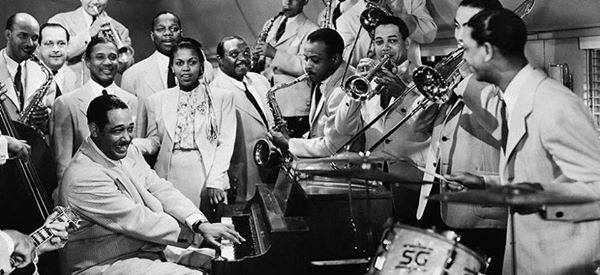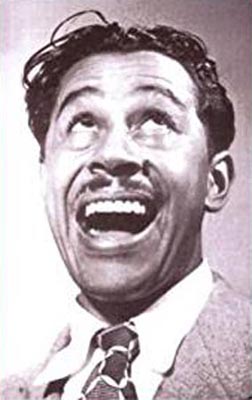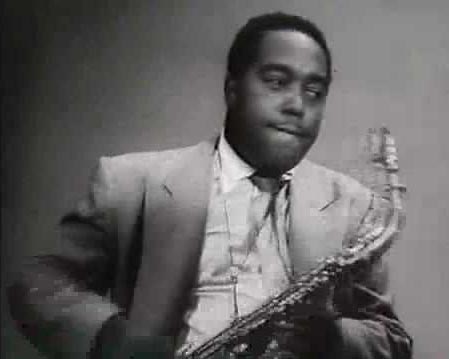
[Some computers might ask you to allow the music to play on this page]
The Mooche |
The Mooche was written by Duke Ellington and Irving Mills in 1928. In 1933 Ellington explained that the title referred to 'a certain lazy gait peculiar to some of the folk of Harlem'.
Over time the word has found its way into common usage with two definitions. Similar to the composition, it is defined as 'to walk or do things slowly and without much purpose' (e.g 'Stop mooching around in your room and do something useful' or 'We spent the afternoon mooching around the shops'.
An alternative definition is 'to borrow from people or ask them to give you things without paying for them or intending to return them' (e.g. 'You're old enough to get a job and stop mooching off your family' or 'He mooched a few beers from me as we watched the game') [Cambridge Dictionary].
The 'easy going' definition is expressed well in the Duke Ellington tune. Here is a video of the Duke Ellington Orchestra playing The Mooche. The drummer is Louie Bellson, Ray Nance is on trumpet with the three clarinettists who it is suggested are Harry Carney, Russel Procope and Jimmy Hamilton and that the trombonist is 'Tricky' Sam Nanton. The arrangement reflects Duke Ellington's 'Jungle Style' period.
Writing in The Guardian in 2009, John Fordham says: '.....The group's characteristic "jungle sound" began to develop with the Miley/Ellington collaboration East St Louis Toodle-Oo, and in April 1927 came Black and Tan Fantasy, which furthered the then audacious use of multiple themes, key changes, and richly coloured textural effects and harmonies. The band played its most famous residency – at Harlem's Cotton Club – between 1927 and 1931, accompanying the ambitious and hugely popular dance-theatre routines ushered in by the 20s "Harlem renaissance" of African-American culture .......'

Accompanying this 1931 recording of Ellington's Echoes Of The Jungle we read: 'In December 1927 Duke Ellington's band opened in Harlem at the Cotton Club. They stayed there until 1932, when their level of success permitted them to tour Europe. By 1927, Duke became involved with band agent Irving Mills, who signed Ellington to a contract that gave Mills 50% of Ellington's earnings and 55% of any song royalties due to Ellington's compositions. It was Mills who managed to get Ellington booked into the Cotton Club, and where his music first became known as "Jungle style". Some of his recordings at this time credit him as 'Duke Ellington and the Jungle Band'.
The 1920s to early 1930 years were a very colourful time in American music and film history. Hollywood was turning out such films as 'King Kong' and the early 'Tarzan' movies. Meanwhile, 'Tin Pan Alley' was also turning out such songs as "Jungle Jamboree" 1920, "Babes in the Jungle" 1926, "The Jungle Rhythm" 1929, and "Call of the Jungle", plus others. Many of the Harlem clubs also followed this "Jungle" theme. So it was quite natural for some orchestras, including Ellington's, to also adopt the "Jungle" theme'.

Three years after Ellington introduced The Mooche, Cab Calloway followed it with his song Minnie The Moocher, loosley based on Willie The Weeper. Here we find reference to the second definition of 'mooching'. Wikipedia tells us 'The lyrics are heavily laden with drug references. The character "Smokey" is described as "cokey", meaning a user of cocaine; the phrase "kick the gong around" was a slang reference to smoking opium. The November 22, 1951 issue of Jet magazine gives this account of the "Minnie" on whom the song was based: Minnie "The Moocher" has died. She was a familiar figure in downtown Indianapolis. A 82-year-old woman whose real name was Minnie Gayton, she acquired the quaint nickname of "The Moocher" by regularly begging food from grocers and carting it off in a baby buggy. She slept in doorways, on porches and in garages. During the record-breaking blizzard, her body was found on a porch, blanketed with snow. She died from exposure'.
'Calloway also wrote an extended version, adding verses that describe Minnie and Smokey going to jail; Minnie pays Smokey's bail, but he abandons her there. Another verse describes her tempting "Deacon Lowdown" when she "wiggled her jelly roll at him". Finally, they took Minnie to "where they put the crazies", where she dies. This explains why both the short version and the long version end with the words "Poor Min, poor Min". Minnie herself is mentioned in a number of other Cab Calloway songs, including "Minnie the Moocher's Wedding Day", "Ghost of Smoky Joe", "Kickin' the Gong Around", "Minnie's a Hepcat Now", "Mister Paganini - Swing for Minnie", "We Go Well Together", and "Zah Zuh Zaz". Some of these songs indicate that Minnie's boyfriend Smoky was named Smoky Joe as well'.
Cab Calloway and his Orchestra playing Minnie The Moocher.
Folks, here's a story 'bout Minnie the Moocher
She was a red-hot hoochie-coocher
She was the roughest, toughest frail
But Minnie had a heart as big as a whale
She messed around with a bloke named Smokey
She loved him though was cokey
He took her down to Chinatown
And he showed her how to kick the gong around
She had a dream about the King of Sweden
He gave her things that she was needin'
He gave her a home built of gold and steel
A diamond car with a p-la-ti-num wheel
He gave her his townhouse and his racing horses
Each meal she ate was a dozen courses
She had a million dollars worth of nickels and dimes
She sat around and counted them all a million times
Now Min and Smokie, they started jaggin'
They got a free ride in a wagon
She gave him money to pay her bail
But he left her flat in the county jail
Poor Min met old Deacon Lowdown
He preached to her that she ought to slow down
But Minnie wiggled her jelly roll
And Deacon Lowdown yelled, "Lord save my soul!"
They took her where they put the crazies
Now poor Min's kicking up those daisies
You've heard my story this is her song
She was just a good gal, but they done her wrong
Poor Min, Poor Min, Poor Min.
(I have left out the 'Hi-De-Hi' choruses)
At the age of 72, Cab Calloway reprised the song in the movie The Blues Brothers, singing the number while the brothers mooched around outside.
More recently we can check out what the University of Leicester Big Band did in this video of Minnie The Moocher from 2016 - Brennan Alleyne is the vocalist and Tom Starachen takes the trombone solo.
That brings us to Charlie Parker and his 1946 tune Moose The Mooche based on the changes of I Got Rhythm. Wikipedia again says: 'It was written shortly after his friend and longtime musical companion Dizzy Gillespie left him in Los Angeles to return to New  York City. Parker had been a long time heroin addict and some historians suggest that the song was named after the drug dealer, Emry "Moose the Mooche" Byrd, who sold him drugs for several years before being arrested'.
York City. Parker had been a long time heroin addict and some historians suggest that the song was named after the drug dealer, Emry "Moose the Mooche" Byrd, who sold him drugs for several years before being arrested'.
Charlie Parker
Moose The Mooche was written and recorded during Charlie Parker's sessions for the Dial label. The Los Angeles Magazine tells us: '.... Local fan Ross Russell, owner of the Tempo Music Store on Hollywood Boulevard, was a bebop fanatic; he started Dial Records in 1946 specifically to record Parker’s music ...... Russell managed to assemble top-notch talent for Parker’s Dial sessions. Trumpeter Howard “Maggie” McGhee, pianists Dodo Marmarosa and Jimmy Bunn, bassist Bob Kesterson, and drummer Roy Porter all jammed with Parker at Little Tokyo’s semi-legal Finale Club. But the most famous participant was Emry Byrd. While manning a newsstand on Central Avenue, Byrd supposedly sold the best heroin in the city; Parker was so appreciative that he not only named one of his most famous songs “Moose the Mooche” after Byrd but signed over half of his royalties for his Dial recordings to the dealer, whose address, in short time, was switched to San Quentin. According to drummer Roy Porter, who drove Parker to the March 28, 1946 session, Parker started writing “Mooche” in the car at 35th and Maple Streets and finished it by the time they got to Radio Recorders Studios on Santa Monica Boulevard in Hollywood .....'
Which definition of 'Mooche' gave Emry Byrd his nickname I do not know, but in John Gennari's book Blowin' Hot And Cool : Jazz And Its Critics, Gennari writes that: 'Emry 'Moose The Mooche' Byrd, a Central Avenue paraplegic pusher who made his way around jazz clubs in a wheelchair .... mooched the profits from this recording and several others from Parker's first Dial session ...'.
Moose The Mooche has gone on to be recorded by many jazz musicians and you could mooche through the uploads on YouTube all day long, but I have chosen this video led by baritone sax and flugelhorn from Armenia. It comes from a concert at the Cafesjian Center for the Arts in Yerevan, Armenia with David Melkonyan (baritone sax) and Yervand Margaryan (flugelhorn).
To finish, let's rewind to the Duke Ellington tune with this video of the remarkable Cohen family playing The Mooche.
Yuval Cohen (soprano saxophone): Anat Cohen (clarinet); Avishai Cohen (trumpet) with Aaron Goldberg (piano).
photo by Jimmy and Dena Katz
More Tracks Unwrapped:
© Sandy Brown Jazz 2018
Click HERE to join our mailing list